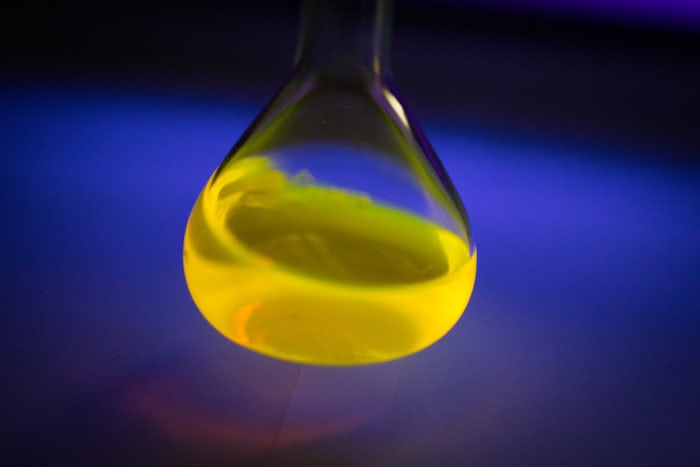Thanks to rising sea and atmospheric carbon dioxide levels, the search for efficient sources of renewable energy are more urgent than ever. Although options such as solar and wind power have been gaining speed, for these energy sources to go mainstream, the issue of storage must be addressed, and the answer may lie in an unlikely material: a fluorescent dye called BODIPY.

Could this dye be used to power your future home or car? Image source: University at Buffalo.
Short for boron-dipyrromethene, BODIPY, according to researchers at the University at Buffalo, is hiding two unusual chemical properties that make it a potential candidate for stockpiling energy in a redox flow battery: storing electrons and participating in electron transfer. This discovery is important because next-generation batteries need to do these things very well in order to store and deliver energy at grid scale. Originally used as a sensor to identify proteins, BODIPY is also capable of performing these functions.
“As the world becomes more reliant on alternative energy sources, one of the huge questions we have is, 'How do we store energy?' What happens when the sun goes down at night, or when the wind stops?” said lead researcher, Dr. Timothy Cook. “All these energy sources are intermittent, so we need batteries that can store enough energy to power the average house.”
Redox flow batteries could address this problem because their energy tanks can easily be enlarged to store vast amounts of energy without a corresponding exponential increase in cost, which is in contrast to other systems, such as Lithium-ion technology. Although champions of flow technology say these batteries are safer and more cost-effective compared to the Li-ion variety, which dominates the market for battery-based energy storage systems, they haven’t been able to reach the same level of commercial success despite developments promising to lower costs and double energy density. So can BODIPY give redox flow batteries the jolt they need?
To test how a BODIPY-based battery would run, the team dissolved PM 567, a powered BODIPY dye, in a solvent and repeatedly charged and drained it across the course of 100 cycles. What they found was that the compound was able to store and transfer electrons for the entire period without degrading, unlike many other chemicals. Although the researchers only tested PM 567, since different BODIPY varieties share chemical properties, based on the results, it’s possible that other dyes would be able to store energy just as well. Based on the results, the researchers predict that BODIPY batteries would be able to generate an estimated 2.3 volts of electricity.
On a separate note, the study's use of a single substance for the redox storage in both the cathodic and the anodic compartment is another notable feature, according to associate professor in inorganic chemistry at the University of Calgary, Roland Roesler, who was not involved in the research.
“This study adds to the body of knowledge in the field, especially in regard to the non-aqueous systems, and helps bring it closer to applications,” said Roesler. “All redox flow batteries produced on applicative scale to date have been water based, and although there is a lot of promise for future development, neither of the existing systems could be called a commercial success. Most notably, this study uses one single substance for the redox storage in both the cathodic and the anodic compartment. This is a major advantage akin to that of the vanadium system, which has been by far the most successful so far.”
The team's findings were originally published in ChemsusChem .
Source: University at Buffalo
Advertisement
Learn more about Electronic Products Magazine





